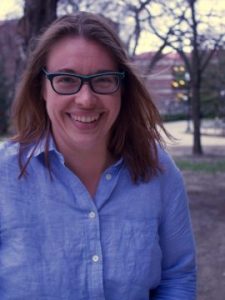 We are pleased to announce that Dr. Anne-Michelle Tessier will be giving a talk at the School on Wednesday 10 April as part of the School’s 50th anniversary colloquium series.
We are pleased to announce that Dr. Anne-Michelle Tessier will be giving a talk at the School on Wednesday 10 April as part of the School’s 50th anniversary colloquium series.
Dr. Anne-Michelle Tessier joined UBC in January 2019 as an Assistant Professor in the Department of Linguistics. She is primarily a theoretical phonologist who studies acquisition. Dr. Tessier completed her PhD at UMass Amherst in 2006 under the supervision of Joe Pater and was appointed as an Assistant and then Associate Professor in Linguistics at the University of Alberta for a decade. Between 2016 and 2018, she was affiliated with the University of Michigan in Ann Arbor, both as a Lecturer and a Research Investigator at the Center for Human Growth and Development, and since 2016 has been an Adjunct Professor in Linguistics at Simon Fraser University. Her research interests include constraint-based grammars, learning algorithms, lexical avoidance, U-shaped development, L2 production and perception in childhood, and prosodic processing with cochlear implants.
WHEN: Wednesday 10 April 2019, 12:05-12:50pm
WHERE: Friedman Room 355,
TITLE: Phonological processing in children with and without cochlear implants (joint work with Ioulia Kovelman, Rennie Pasquinelli, Xiaosu Hu, Greg Basura and Teresa Zwolan)
ABSTRACT: For children with prelingual sensorineural hearing loss, early-implanted cochlear implants (CI) can provide sufficient auditory input for the development of speech perception, but CIs do not transmit the full detail of formant structure and F0 used by normal-hearing listeners to interpret spoken language. The consequences of the CI’s degraded input for how phonological knowledge develops, while known to be crucial to ultimate language success, are not well understood independent of other factors (e.g. Schwarz et al 2013; McMurray et al, 2016).
This study reports two English phonological processing tasks with children ages 7-11 who received a CI before age 2, compared to age-matched children with normal hearing (NH). In our rhyme judgment task, children discriminated vowels in CVC syllables: these include easy non-rhymes whose vowels differ in formants, amplitude and duration (comb vs. ham, neck vs. duck) and hard non-rhymes that differ primarily in formant structure (tone vs. town, peck vs. pick). In our novel sentence-matching task, children simply judged whether pairs of sentences contain the same words, while ignoring differences in intonation that signal declaratives, questions, and narrow subject focus (e.g. MELISSA loves an iguana! vs MELISSA loves an iguana?!). While completing these tasks, children’s brain activation was simultaneously registered using functional near-infrared spectroscopy (fNIRS), which continuously measures localized changes in cortical blood flow.
In our preliminary results (31 NH and 6 CI children), both groups show similar trends in response accuracy, though the difficulty of harder non-rhymes and sentence-level intonation is exacerbated for CI listeners. The preliminary fNIRS data suggest that NH children show reliable differences between lexical (IFG) and prosodic (tempo-parietal) sentence processing, whereas CI recipients trend towards an overall greater reliance on lexical processes. These results will be discussed with respect to bigger picture questions regarding the fine-tuning of phonological processing across childhood, and how specific aspects of phonological structure might be used to evaluate or ultimately predict children’s language perception success with CI.